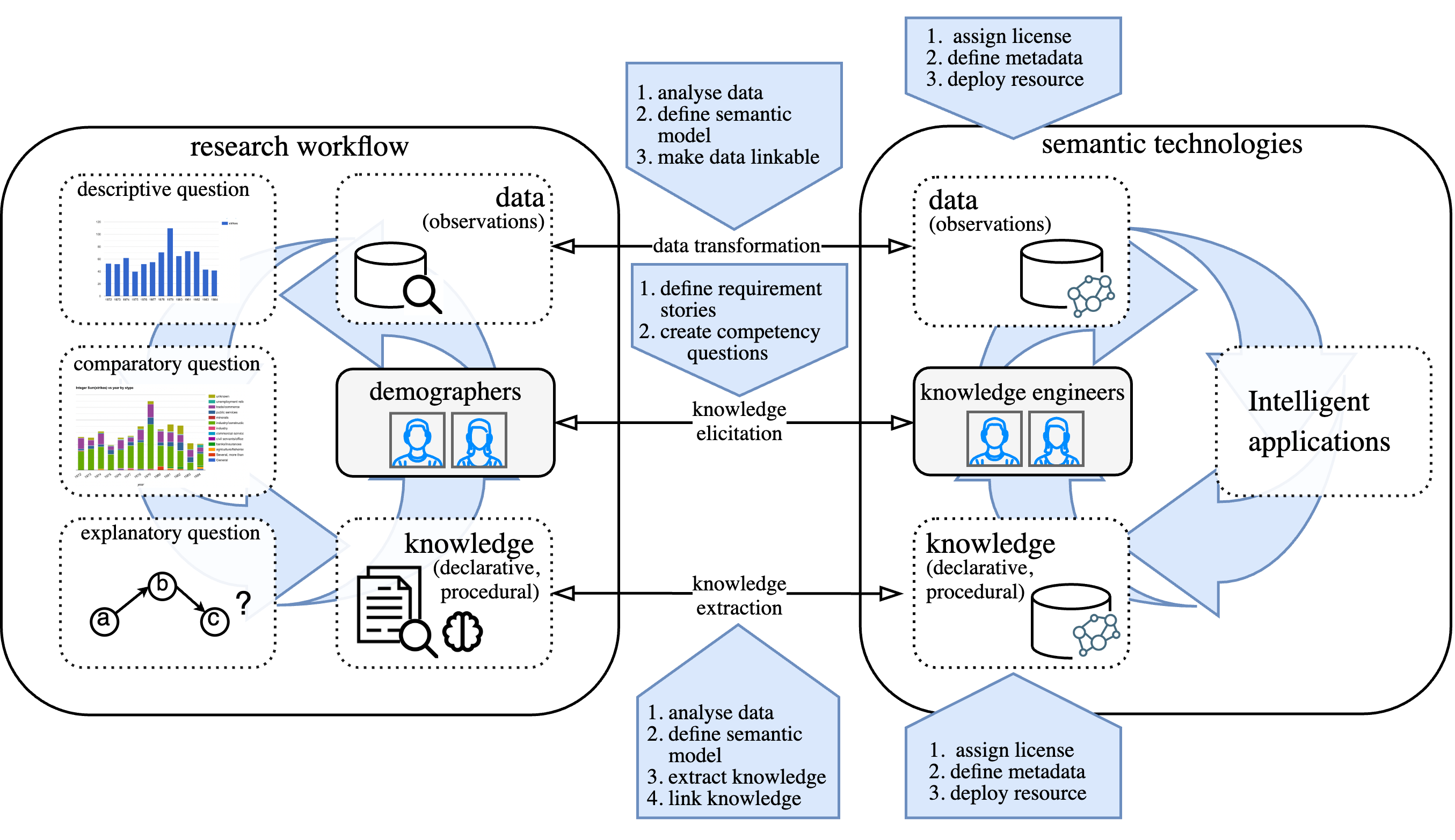## Name
MIRA
## Full title
MIRA - A Knowledge Graph for Social Demography Hypotheses and Findings.
## Application domain
Semantic web, Graphs, Natural Language Processing
## Keywords
Social Demography, Knowledge Graph, Scientific Hypotheses, Information Extraction
## Description
This github presents the MIRA-KG, a knowledge graph designed to capture hypotheses and findings in social demography research. The resource aids researchers in understanding the trends and patterns revealed in social demography, and use them to discover biases, discover knowledge, and derive novel questions.
## Overview
In the research workflow of a social historian or social demographer, research questions commonly include (i) descriptive questions, (ii) comparative questions, and (iii) explanatory questions. Here, each question is answered based on the output from a previous question or dataset, see the image below. An example workflow, and how such a workflow can be made more FAIR, is shown below.

In social demography, work has been done formally describing observational data, such as census data hosted as linked data at the International Institute of
Social History (IISH). To the best of our knowledge, no studies formalise knowledge such as hypotheses and findings on social demography, whereas these are important in each of the
steps of the scientific workflow of a social historian (see declarative/procedural knowledge in the figure above). The research process, hypotheses and findings are mostly written up in scientific documents
in natural language, which can be ambiguous and imprecise. Such fields can thus benefit from adopting the FAIR data principles, to reduce unclarity and ambiguity in the research workflow of a social demographer.
The [MIRA ontology](https://w3id.org/mira/ontology/) describes this process: it links datasets of observations to research questions, to accommodate the research workflow of a social demographer/social historian towards more reusable, reproducible research. We also populate the ontology with structured research questions on health inequality, extracted from abstracts of research papers, and is published on [Zenodo](https://doi.org/10.5281/zenodo.10286846), and queriable via a [SPARQL endpoint](
https://api.druid.datalegend.net/datasets/lisestork/MIRA-KG/services/MIRA-KG/sparql).
This [github](https://github.com/muhai-project/mira/) contains the ontology, example annotations, scripts to produce structured annotations automatically from paper abstracts (explanatory questions and metadata of evidence used to answer the RQs), and SHACL shapes for the validation of generated annotations.
### Requirements
1. clone the project
```
git clone https://github.com/muhai-project/mira.git
```
2. set up an environment (like anaconda) from the requirement.txt file
```
pip install -r requirements.txt
```
### Usage examples:
The semantify.py script turns research paper abstracts of papers on social demography into RDF according to the MIRA ontology. It does so by: (i) prompting a Large Language Model to annotate paper abstracts, (ii) mapping concepts to terms from NCBO BioPortal ontologies and Geonames. An example annotation is shown in the figure below:


To test the code, you can use the example paper_file.pkl file with papers on social health inequality.
```
python semantify.py --paper_file ../data/paper_file.pkl --api_key "your api key" --output ../data/test_output.ttl --max 1 --view 1
```
The location of the input file, the openAI api key, and the output file are required arguments. Max and view are optional and indicate how many papers to process, and whether to print the serialised RDF after each step. _To check whether all works as expected, we recommend to first set these to 1 and True, before processing a large batch._
The --paper_file argument expects the location of a pickle file (.pkl) which consists of a list of dictionaries with the following keys:
dict_keys(['paperId','title','abstract','year','publicationDate','authors','references'])
These can, for instance, be retrieved from Semantic Scholar:
```
from semanticscholar import SemanticScholar
sch = SemanticScholar()
results = sch.search_paper('',year=, fields_of_study=[''])
papers = [sch.get_paper(result.paperId) for result in results]
```
You can use the validate.py script to validate the set against a set of SHACL shapes, developed according to a set of data quality criteria.
```
python validate.py --batch_file ../data/test_output.ttl --shacl_file ../validation/shacl-shapes.ttl --validation_output validation_results.ttl --view 1
```
## Ontologies
[ontology/ontology.ttl](https://github.com/muhai-project/mira/blob/main/ontology/ontology.ttl)
## Programming languages
Python
## License
Apache license 2.0
## Citation
@InProceedings{10.1007/978-3-031-60635-9_12,
author="Stork, Lise and Zijdeman, Richard L. and Tiddi, Ilaria and ten Teije, Annette",
editor="Mero{\~{n}}o Pe{\~{n}}uela, Albert and Dimou, Anastasia and Troncy, Rapha{\"e}l and Hartig, Olaf and Acosta, Maribel and Alam, Mehwish and Paulheim, Heiko and Lisena, Pasquale",
title="Enabling Social Demography Research Using Semantic Technologies",
booktitle="The Semantic Web",
year="2024",
publisher="Springer Nature Switzerland",
address="Cham",
pages="199--216",
isbn="978-3-031-60635-9"
}
## DOI
10.1007/978-3-031-60635-9_12,
10.5281/zenodo.10286845
## Contact
Lise Stork, l.stork@uva.nl
## Contributors
Lise Stork, Richard Zijdeman, Ilaria Tiddi, Annette ten Teije
## Owner
muhai-project
## Owner type
Organization
## Repository status
Active
## Acknowledgment
This work was funded by the European MUHAI project (Horizon 2020 research and innovation program) under grant agreement
number 951846. We thank Tobias Kuhn and Inès Blin for the insightful discussions that contributed to this work.
---